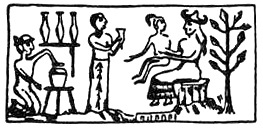|
NINMAH is seen here together with her flasks
and instruments. In my painting she is pictured together with the seven
'birth-goddess' who were needed initially as surrogate mothers to bring
to term the embryos of the newly created species. The Baobab tree in the
background and EN.KI's crocodile skin cape establish that this momentous
event took place in Southern Africa, The chameleon seen in the tree, is
an important player in many African creation epics. It was the chameleon
that was sent down to inspect the new world after the Creation. The chameleon
was sent to spy, and for this reason many African people look upon the
chameleon with suspicion and fear.
In the Sumerian language and also in Persian, 'Hu-man' means 'god-man'.
According to the Atrahasis texts, the male, called Adamu was black-headed
and had a smooth reddish skin, although the birth-mothers including the
first one, NINMAH herself, were fair-skinned. The first female human,
Tiamat, was as white-skinned as were the 'gods' themselves. It appears
that race differences were inherent in the initial creation of mankind.
Further translations inform us that the first created couple, Adamu and
Tiamat who were kept in the E.DIN, were not able to procreate without
further genetic modification. It was essential that they should be able
to breed so that it might no longer be necessary to use the birth-goddesses
for incubation of the embryos. That was essentially a slow process, and
the gods working in the mines were getting restless and impatient and
demanded the delivery of the Primitive Workers they had been promised.
EN.KI in the role of the Serpent, then conducted further genetic manipulation
which made it possible for the humans to breed. EN.LIL was furious and
again he accused EN.KI of 'playing God'. He feared that soon man would
eat of the 'Tree of Life' and thus acquire the longevity which the ANUNNAKI
seemed to possess. EN.LIL banished Adamu and Tiamat from the E.DIN, but
since they were now able to procreate, the human race multiplied.
After some time had passed EN.KI discovered that the first generation
of black-headed humans produced by the initial process, gradually regressed
and began to lose their promising faculties. They were no longer as useful
as they had been at first. They continued to breed however and in the
AB.ZU (in Africa), the miners had their relief workers as they had been
promised.
To further his quest to produce a 'civilized man', EN.KI personally inseminated
two earthling females who gave birth to a son and daughter. They were
named Adapu and Titi. These two new humans were bright and intelligent
and were brought up in the home of EN.KI as children of the 'gods'. This
mirrors the raising of Moses in the house of the Pharaoh which took place
many generations later. Adapu and Titi were able to procreate and did
not regress as they grew older. Adapu and Titi had two sons who were named
Ka.in and Abael, and later a third son named Seth was born to them, as
were many other offspring.
According to the aim of the gods, 'civilized man' had been created. A
step up in evolution from Homo Sapiens, these may well have been the first
'Homo Sapiens Sapiens' from whom have descended the whole of the human
race.
It appears that the Sumerian gods in general, had absolutely no interest
in mankind other than his usefulness to them as a slave. EN.LIL had been
against their creation and particularly their procreation from the time
of the mutiny. About 13,000 years ago the gravitational stress incurred
by the nearby orbital passage of NI.BIRU caused the Antarctic ice-shelf
to dislodge and slide into the southern oceans. A massive tidal wave occurred
and resulted in the flood of antiquity. A series of natural events which
the ANUNNAKI had observed, had convinced them that a massive flood would
occur, and EN.LIL saw this as an opportunity to drown and destroy the
humans altogether.
However EN.KI, who was man's co-creator, always protected the humans against
the repeated efforts of his half-brother to bring them harm. By secretly
instructing Ziusudra (also known as Utnapishtim or Noah) to build a boat
and take on board all the seed (DNA) of the animals and plants, EN.KI
ensured the survival of the human race and of many forms of life which
would otherwise have perished in the flood. EN.LIL is often portrayed
in the Old Testament as a wrathful 'God', whose relationship with humans
was entirely self-serving. He was opposed to their very existence and
his sole motivation was to use and manipulate, oppress and control them.
During the years after the flood, armies of humans were used by the 'gods'
to fight in the wars which the 'gods' waged amongst themselves.
After the waters of the flood had receded and the ANUNNAKI 'gods' realized
and acknowledged to each other that they had come to depend greatly on
the humans who had survived. Even EN.LIL ultimately came to regard their
existence as 'destiny', which they considered inevitable, as opposed to
'fate', over which they believed they had some control. They decided to
assist mankind to achieve a certain limited degree of independence. They
introduced the concept of 'Kingship' so that via intermediaries whom they
appointed, they could better control mankind. They established a priest
class and temples and shrines so that they, as man's 'Creator' could be
worshipped by the humans.
The right hand section of the painting portrays DUMUZI, who brought to
Earth from NI.BIRU, the four-legged beasts of the field, specifically
sheep and probably cows as well, and also wheat and bees which had not
formerly existed on Earth. The purpose of this 'benevolence' was initially
to enable the earthlings to provide food for the 'gods'.
In one final war of the 'gods', by means of terrible weapons of mass destruction,
Sodom and Gomorrah as well as the ANUNNAKI settlements in the Sinai Peninsula
were destroyed, and much of the surface ground from the Dead Sea to North
Africa was vitrified and scorched. Unexpectedly, in the aftermath of this
devastation, winds from the Atlantic blew the by-products of these weapons
westwards. Evil-bearing winds swept over Mesopotamia killing everything
in their path. There was no escape. The ANUNNAKI leaders fled to higher
ground in the area of Baalbek, in present day Lebanon. Only Babylon to
the north was spared.
Perhaps as a result of this disaster, coupled with the fact that the gold,
was either no longer abundant, or was no longer needed, the 'gods' decided
to leave the Earth in stages. (around 4,000 BC). Before leaving, the 'gods'
in an attempt to assist man in his struggle to survive and to prosper,
decided to pass on to him all kinds of knowledge and skills. This seems
to indicate that they were not totally amoral, or without some compassion
for the creature they had created.
In the upper right of the painting is a winged image of a resigned EN.LIL,
finally giving his blessing to mankind, the inheritors of the Earth. Much
history and other information was dictated to Sumerian priests and scribes
by the ANUNNAKI 'gods'. This would explain the otherwise inconceivably
rapid emergence 6,000 years ago, of a highly developed civilization with
an unprecedented degree of technical sophistication, and areas of knowledge
which they could not possibly have acquired by themselves. I refer particularly
to knowledge of the planets described in detail by the Sumerians, knowledge
which has only been recently re-discovered during the last 200 years.
They also left detailed records of an evolved system of administration
and of legal and ethical practises based on surprisingly humane principles.
The first indigenous civilization appeared in Sumer and with the help
of the 'gods' seems to have prospered and flourished.
I am not an academic or a historian, but I find magic in this history
and I have attempted to impart that magic to a work of art. Note that
I have used in this painting verifiable artefacts and ideas that have
been recorded in the Mesopotamian clay tablets and in Biblical and other
scriptures and sacred writings.
Raymond Andrews – Artist.
|
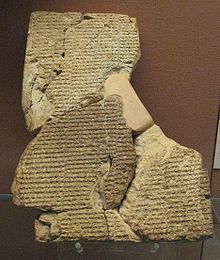

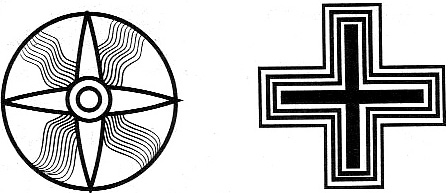
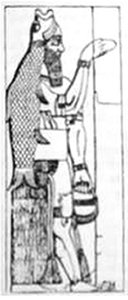 ....................
....................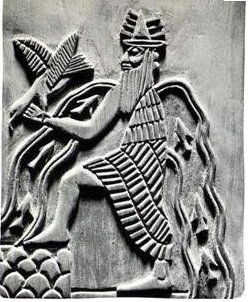
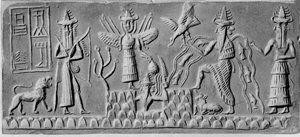
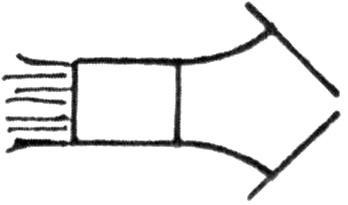
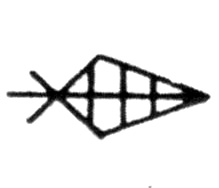
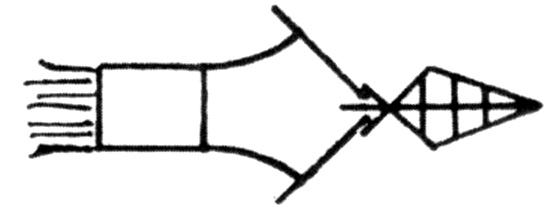

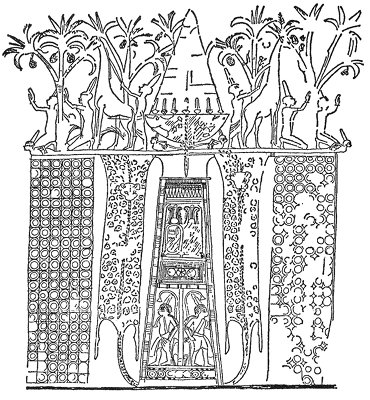
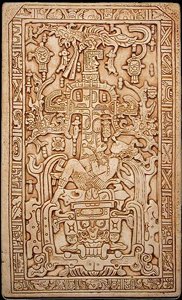
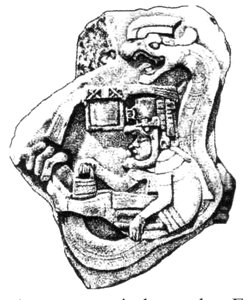
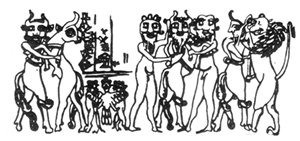 .............
.............